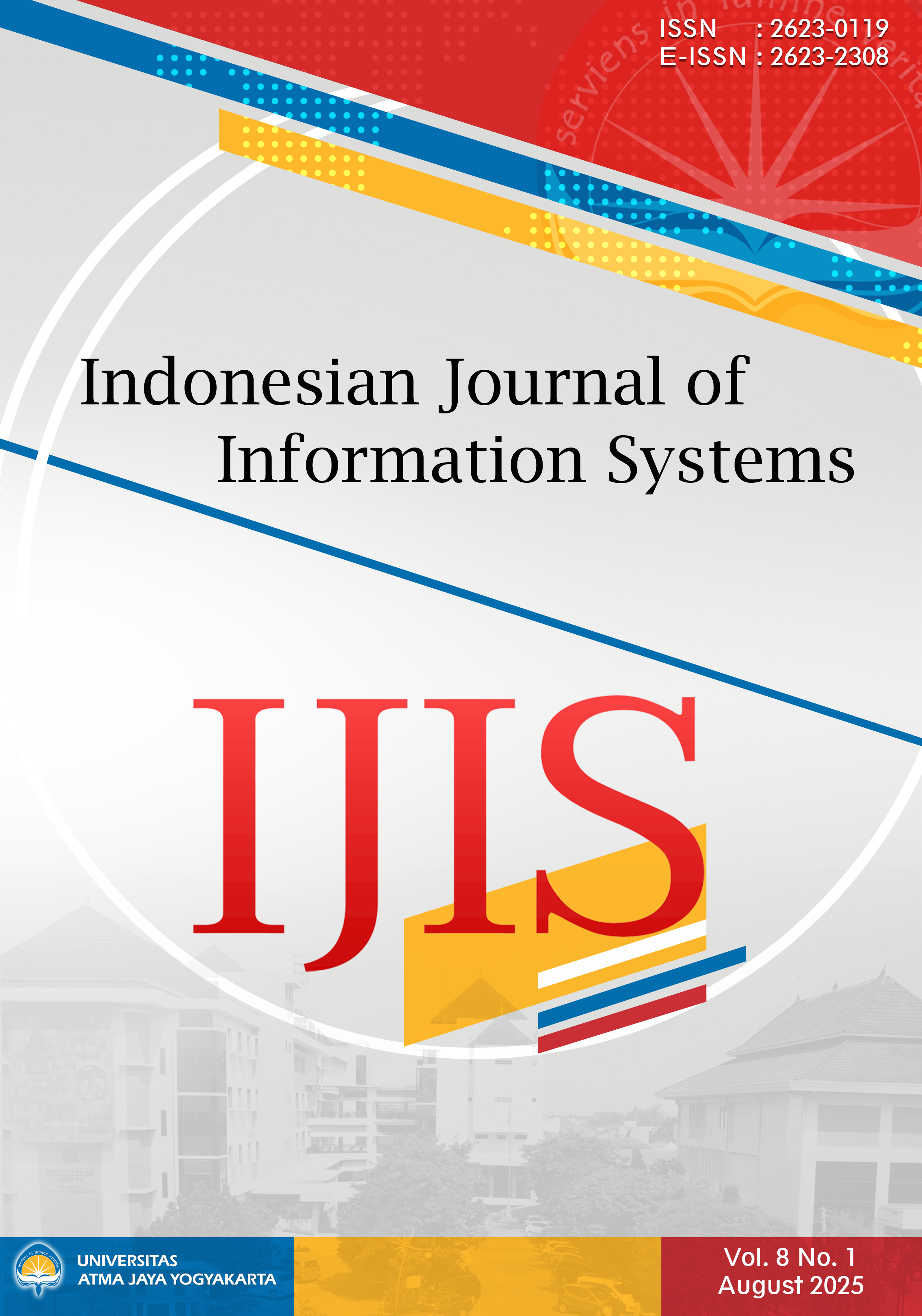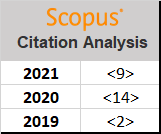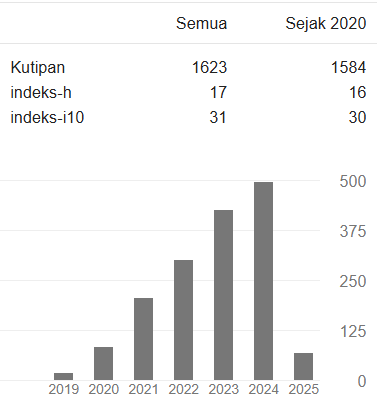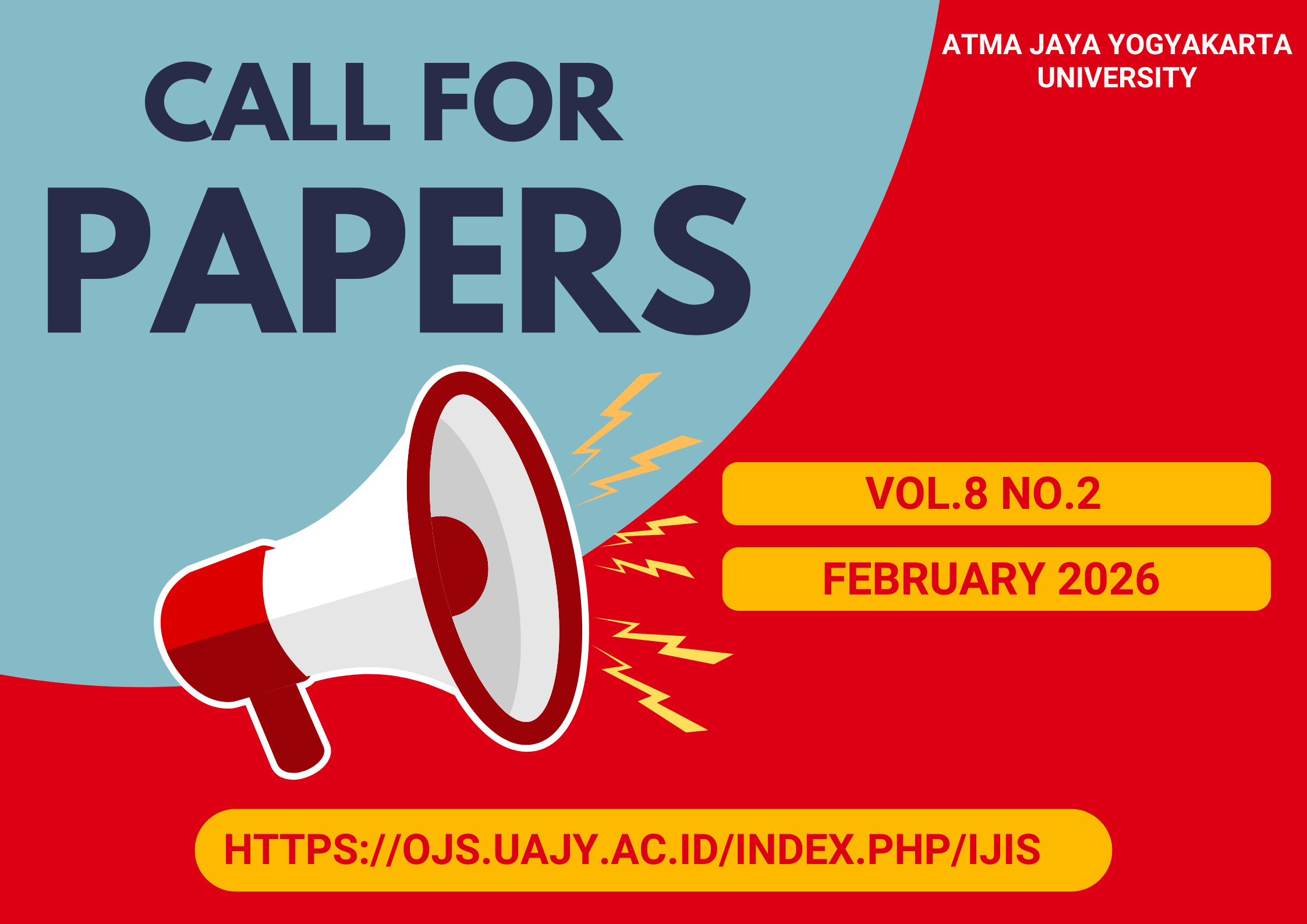Development of Foot Mat Sensor Technology for Foot Identification and BMI-Based Biomechanical Risk Prediction
DOI:
https://doi.org/10.24002/ijis.v8i1.11505Abstract
This study advances the Foot Mat Sensor (FMS) technology to discern foot morphology and forecast biomechanical vulnerabilities predicated on Body Mass Index (BMI). The proposed system amalgamates the analysis of plantar pressure with various biomechanical parameters, including heel pressure, midfoot pressure, forefoot pressure, and foot contact area (FCA). Data were collected from ten participants exhibiting a spectrum of BMI, foot morphology (High Arch, Normal Arch, and Low Arch), foot length, contact area, and asymmetrical plantar pressure. The findings indicated a statistically significant correlation between elevated BMI (>25), irregular plantar pressure distribution, and heightened biomechanical risk. Participants with high BMI and Low Arch (LA) foot morphology demonstrated an augmented risk, with plantar pressure asymmetry ≥20 kPa as the principal indicator. The prediction model founded on the Random Forest algorithm attained an accuracy of 85% in categorizing biomechanical risk into low, medium, and high classifications. The Digital Footprint Scanner technology, innovated through this research, is anticipated to augment the efficacy of personalized and precise diagnostics and the prophylaxis of biomechanical injuries. This endeavor contributes to formulating a data-driven system for the early detection of biomechanical risks, with applications in medicine, athletics, and rehabilitation.
References
[1] Ms. D. D. Kore and Dr. U. L. Bombale, “A Review on Various Plantar Pressure Measurement Systems,” International Journal of Trend in Scientific Research and Development, vol. Volume-2, no. Issue-2, pp. 130–133, 2018, doi: 10.31142/ijtsrd7076.
[2] A. H. Abdul Razak, A. Zayegh, R. K. Begg, and Y. Wahab, “Foot plantar pressure measurement system: A review,” Jul. 2012. doi: 10.3390/s120709884.
[3] S. R. Donahue and M. E. Hahn, “Estimation of gait events and kinetic waveforms with wearable sensors and machine learning when running in an unconstrained environment,” Sci Rep, vol. 13, Dec. 2023, doi: 10.1038/s41598-023-29314-4.
[4] P. A. Butterworth, K. B. Landorf, S. E. Smith, and H. B. Menz, “The association between body mass index and musculoskeletal foot disorders: a systematic review.,” Obes. Rev. an Off. J. Int. Assoc. Study Obes., vol. 13, no. 7, pp. 630–642, Jul. 2012, doi: 10.1111/j.1467-789X.2012.00996.x.
[5] A. P. Hills, E. M. Hennig, N. M. Byrne, and J. R. Steele, “The biomechanics of adiposity--structural and functional limitations of obesity and implications for movement.,” Obes. Rev. an Off. J. Int. Assoc. Study Obes., vol. 3, no. 1, pp. 35–43, Feb. 2002, doi: 10.1046/j.1467-789x.2002.00054.x.
[6] S. P. Messier, D. J. Gutekunst, C. Davis, and P. DeVita, “Weight loss reduces knee-joint loads in overweight and obese older adults with knee osteoarthritis.,” Arthritis Rheum., vol. 52, no. 7, pp. 2026–2032, Jul. 2005, doi: 10.1002/art.21139.
[7] D. L. Riddle and S. M. Schappert, “Volume of ambulatory care visits and patterns of care for patients diagnosed with plantar fasciitis: a national study of medical doctors.,” Foot ankle Int., vol. 25, no. 5, pp. 303–310, May 2004, doi: 10.1177/107110070402500505.
[8] S. C. Wearing, E. M. Hennig, N. M. Byrne, J. R. Steele, and A. P. Hills, “The biomechanics of restricted movement in adult obesity,” Obes. Rev., vol. 7, no. 1, pp. 13–24, doi: https://doi.org/10.1111/j.1467-789X.2006.00215.x.
[9] Y. Fan, Y. Fan, Z. Li, C. Lv, and D. Luo, “Natural Gaits of the Non-Pathological Flat Foot and High-Arched Foot,” PLoS One, vol. 6, no. 3, p. e17749, Mar. 2011,[Online].Available:https://doi.org/10.1371/journal.pone.0017749
[10] S. Sudhakar et al., “Impact of various foot arches on dynamic balance and speed performance in collegiate short distance runners: A cross-sectional comparative study,” J. Orthop., vol. 15, no. 1, pp. 114–117, 2018, doi: https://doi.org/10.1016/j.jor.2018.01.050.
[11] J. B. Arnold, R. Causby, G. D. Pod, and S. Jones, “The impact of increasing body mass on peak and mean plantar pressure in asymptomatic adult subjects during walking.,” Diabet. Foot Ankle, vol. 1, 2010, doi: 10.3402/dfa.v1i0.5518.
[12] D. B. Wibowo, A. Suprihanto, W. Caesarendra, S. Khoeron, A. Glowacz, and M. Irfan, “A Simple Foot Plantar Pressure Measurement Platform System Using Force-Sensing Resistors,” 2020. doi: 10.3390/asi3030033.
[13] A. Martínez-Nova, R. Sánchez-Rodríguez, P. Pérez-Soriano, S. Llana-Belloch, A. Leal-Muro, and J. D. Pedrera-Zamorano, “Plantar pressures determinants in mild Hallux Valgus.,” Gait Posture, vol. 32, no. 3, pp. 425–427, Jul. 2010, doi: 10.1016/j.gaitpost.2010.06.015.
[14] Tekscan Inc., "F-Scan GO: In-shoe gait analysis system," 2023. [Online]. Available: https://www.tekscan.com/products-solutions/systems/f-scan-system
[15] F. J. Canca-Sanchez et al., “Predictive factors for foot pain in the adult population.,” BMC Musculoskelet. Disord., vol. 25, no. 1, p. 52, Jan. 2024, doi: 10.1186/s12891-023-07144-9.
[16] M. K. Nilsson, R. Friis, M. S. Michaelsen, P. A. Jakobsen, and R. O. Nielsen, “Classification of the height and flexibility of the medial longitudinal arch of the foot.,” J. Foot Ankle Res., vol. 5, p. 3, Feb. 2012, doi: 10.1186/1757-1146-5-3.
[17] O. C. Okezue et al., "Adult Flat Foot and its Associated Factors: A Survey among Road Traffic Officials," Novel Techniques in Arthritis & Bone Research, vol. 3, no. 4, pp. 555616, 2019.
[18] A. Aenumulapalli, M. M. Kulkarni, and A. R. Gandotra, “Prevalence of Flexible Flat Foot in Adults: A Cross-sectional Study.,” J. Clin. Diagn. Res., vol. 11, no. 6, pp. AC17–AC20, Jun. 2017, doi: 10.7860/JCDR/2017/26566.10059.
[19] A. Arzehgar, R. Nia, M. Hoseinkhani, F. Masoumi, S. Sayyed-Hosseinian, and S. Eslami, “An overview of plantar pressure distribution measurements and its applications in health and medicine,” Gait Posture, vol. 117, 2024. [Online]. Available: https://doi.org/10.1016/j.gaitpost.2024.12.022
[20] B. Chen, X. Ma, F. Xiao, P. Chen, and Y. Wang, “Arch index measurement method based on plantar distributed force,” J. Biomech., vol. 144, p. 111326, 2022, doi: https://doi.org/10.1016/j.jbiomech.2022.111326.
[21] S. S. AlAbdulwahab and S. J. Kachanathu, “Effects of body mass index on foot posture alignment and core stability in a healthy adult population.,” J. Exerc. Rehabil., vol. 12, no. 3, pp. 182–187, Jun. 2016, doi: 10.12965/jer.1632600.300.
[22] T. Zheng, Z. Yu, J. Wang, and G. Lu, “A New Automatic Foot Arch Index Measurement Method Based on a Flexible Membrane Pressure Sensor,” 2020. doi: 10.3390/s20102892.
[23] A. Hawrylak, A. Brzeźna, and K. Chromik, “Distribution of Plantar Pressure in Soccer Players.,” Int. J. Environ. Res. Public Health, vol. 18, no. 8, Apr. 2021, doi: 10.3390/ijerph18084173.
[24] K. Tománková, M. Přidalová, Z. Svoboda, and R. Cuberek, “Evaluation of Plantar Pressure Distribution in Relationship to Body Mass Index in Czech Women During Walking.,” J. Am. Podiatr. Med. Assoc., vol. 107, no. 3, pp. 208–214, May 2017, doi: 10.7547/15-143.
[25] R. Dugalam and G. Prakash, “Development of a random forest based algorithm for road health monitoring,” Expert Syst. Appl., vol. 251, p. 123940, 2024, doi: https://doi.org/10.1016/j.eswa.2024.123940.
[26] V. R. Joseph, “Optimal ratio for data splitting,” Stat. Anal. Data Min. An ASA Data Sci. J., vol. 15, no. 4, pp. 531–538, Aug. 2022, doi: https://doi.org/10.1002/sam.11583.
[27] R. Periyasamy and S. Anand, “The effect of foot arch on plantar pressure distribution during standing.,” J. Med. Eng. Technol., vol. 37, no. 5, pp. 342–347, Jul. 2013, doi: 10.3109/03091902.2013.810788.
[28] F. Graziosi, R. Bonfiglioli, F. Decataldo, and F. S. Violante, “Criteria for Assessing Exposure to Biomechanical Risk Factors: A Research-to-Practice Guide-Part 1: General Issues and Manual Material Handling.,” Life (Basel, Switzerland), vol. 14, no. 11, Oct. 2024, doi: 10.3390/life14111398.
[29] T.-H. Chow, Y.-S. Chen, C.-C. Hsu, and C.-H. Hsu, “Characteristics of Plantar Pressure with Foot Postures and Lower Limb Pain Profiles in Taiwanese College Elite Rugby League Athletes.,” Int. J. Environ. Res. Public Health, vol. 19, no. 3, Jan. 2022, doi: 10.3390/ijerph19031158.
[30] K. E. Chatwin, C. A. Abbott, A. J. M. Boulton, F. L. Bowling, and N. D. Reeves, “The role of foot pressure measurement in the prediction and prevention of diabetic foot ulceration-A comprehensive review.,” Diabetes. Metab. Res. Rev., vol. 36, no. 4, p. e3258, May 2020, doi: 10.1002/dmrr.3258.
[31] E. Sutkowska, K. Sutkowski, M. Sokołowski, E. Franek, and S. S. Dragan, “Distribution of the Highest Plantar Pressure Regions in Patients with Diabetes and Its Association with Peripheral Neuropathy, Gender, Age, and BMI: One Centre Study.,” J. Diabetes Res., vol. 2019, p. 7395769, 2019, doi: 10.1155/2019/7395769.
[32] R. Woźniacka, Ł. Oleksy, A. Jankowicz-Szymańska, A. Mika, R. Kielnar, and A. Stolarczyk, “The association between high-arched feet, plantar pressure distribution and body posture in young women.,” Sci. Rep., vol. 9, no. 1, p. 17187, Nov. 2019, doi: 10.1038/s41598-019-53459-w.
[33] S. N. K. Kodithuwakku Arachchige, H. Chander, and A. Knight, “Flatfeet: Biomechanical implications, assessment and management,” Foot, vol. 38, pp. 81–85, 2019, doi: https://doi.org/10.1016/j.foot.2019.02.004.
[34] D. Ohlendorf et al., “Standard reference values of weight and maximum pressure distribution in healthy adults aged 18-65 years in Germany.,” J. Physiol. Anthropol., vol. 39, no. 1, p. 39, Nov. 2020, doi: 10.1186/s40101-020-00246-6.
[35] A. R. Wilzman et al., “Medical and Biomechanical Risk Factors for Incident Bone Stress Injury in Collegiate Runners: Can Plantar Pressure Predict Injury?,” Orthop. J. Sport. Med., vol. 10, no. 6, p. 23259671221104790, Jun. 2022, doi: 10.1177/23259671221104793.
[36] S. Chun, S. Kong, K.-R. Mun, and J. Kim, “A Foot-Arch Parameter Measurement System Using a RGB-D Camera,” 2017. doi: 10.3390/s17081796.
[37] S.-Y. Park and D.-J. Park, “Comparison of Foot Structure, Function, Plantar Pressure and Balance Ability According to the Body Mass Index of Young Adults.,” Osong public Heal. Res. Perspect., vol. 10, no. 2, pp. 102–107, Apr. 2019, doi: 10.24171/j.phrp.2019.10.2.09.
[38] S. Taş, N. Bek, M. Ruhi Onur, and F. Korkusuz, “Effects of Body Mass Index on Mechanical Properties of the Plantar Fascia and Heel Pad in Asymptomatic Participants.,” Foot ankle Int., vol. 38, no. 7, pp. 779–784, Jul. 2017, doi: 10.1177/1071100717702463.
[39] S. Xiong, R. S. Goonetilleke, C. P. Witana, T. W. Weerasinghe, and E. Y. L. Au, “Foot arch characterization: a review, a new metric, and a comparison.,” J. Am. Podiatr. Med. Assoc., vol. 100, no. 1, pp. 14–24, 2010, doi: 10.7547/1000014.
Downloads
Published
How to Cite
Issue
Section
License

This work is licensed under a Creative Commons Attribution-ShareAlike 4.0 International License.
Indonesian Journal of Information Systems as journal publisher holds copyright of papers published in this journal. Authors transfer the copyright of their journal by filling Copyright Transfer Form and send it to Indonesian Journal of Information Systems.

Indonesian Journal of Information Systems is licensed under a Creative Commons Attribution-NonCommercial 4.0 International License.

















